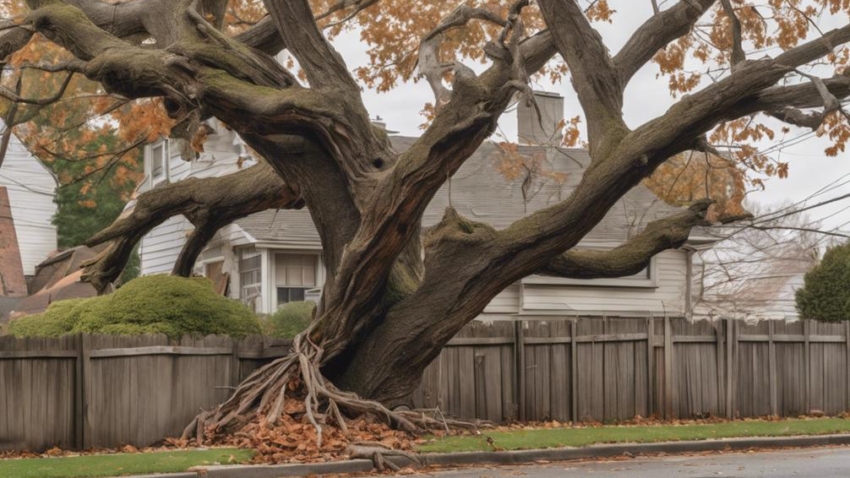
What to Do if Your Neighbor's Tree Is Damaging Your Property
When a neighbor's tree damages their property, they should document evidence, including photos and witness statements, and maintain a damage log. They should then approach their neighbor, choosing the right time and place, using 'I' statements and active listening to find a collaborative solution. It's also important to research local tree ordinances and determine property lines and boundaries. If talks fail, mediation or arbitration may be necessary. By understanding their legal rights and options, they can take informed action. Taking these steps will help resolve the issue; but there's more to learn about preventing future disputes and finding a lasting resolution.
Document the Damage and Evidence
When a neighbor's tree causes damage to your property, promptly documenting the evidence is important to support any potential claims or disputes. This documentation will serve as vital evidence in any insurance claims or disputes that may arise. It's essential to act quickly, as the longer you wait, the more likely it is that evidence will be lost or destroyed.
Start by taking photo evidence of the damage, including close-ups of the specific damage and wider shots of the affected area. These photos will help establish the extent of the damage and can be used to support insurance claims. Additionally, gather witness statements from anyone who may have seen the damage occur or has knowledge of the tree's condition before the incident. These statements can provide valuable context and help establish liability.
Maintain a damage log to track all incidents, including the date, time, and description of the damage. This log will help you keep a detailed record of all incidents and can be used to demonstrate a pattern of damage. Finally, obtain repair estimates from licensed contractors to establish the cost of repairs. These estimates will help you negotiate with your neighbor or their insurance company to secure fair compensation for the damage. By documenting the damage and evidence thoroughly, you'll be well-prepared to support your claims and ensure a successful resolution.
Talk to Your Neighbor First
After documenting the damage, it's time to approach your neighbor and discuss the issue, as resolving the matter amicably is often the best course of action. This conversation is vital in setting boundaries and maintaining neighborhood harmony. Effective communication is key to conflict resolution, so it's essential to approach the conversation calmly and respectfully.
Before initiating the conversation, consider the following tips:
| Conversation Tips | Why It Matters |
|---|---|
| Choose the right time and place | Avoid confrontation in public or when emotions are high |
| Stay calm and objective | Focus on the issue, not personal attacks |
| Use 'I' statements | Express concerns without blaming the neighbor |
| Listen actively | Understand the neighbor's perspective and concerns |
| Focus on solutions | Collaborate to find a mutually beneficial solution |
During the conversation, be prepared to provide evidence of the damage and explain how it's affecting you. Listen to your neighbor's perspective, and work together to find a solution. This collaborative approach can help resolve the issue and maintain a positive relationship. Remember, resolving the matter amicably is often the best course of action, and talking to your neighbor first is a critical step in achieving that goal.
Research Local Tree Ordinances
Understanding local tree ordinances is essential in determining the responsibilities of both property owners and the municipality in maintaining tree health and resolving damage disputes. These ordinances can vary greatly depending on the location, so it's important to research and understand the specific regulations in your area. This research will help you determine if your neighbor is complying with local regulations and if they're taking adequate care of their tree.
Start by visiting your local government's website or contacting your local arborist or public works department to obtain information on tree ordinances. Look for information on tree permits, which may be required for pruning, removal, or planting trees. You'll also want to review the ordinance history to understand how the regulations have evolved over time. This will give you a better understanding of the legal framework surrounding tree maintenance and liability.
Some key questions to ask when researching local tree ordinances include: What are the regulations regarding tree pruning and removal? Are there any specific requirements for tree species or size? Are there any restrictions on tree planting or maintenance near property lines? By understanding the local tree ordinances, you'll be better equipped to navigate disputes with your neighbor and make sure that both parties are meeting their responsibilities in maintaining tree health and resolving damage disputes.
Determine Property Lines and Boundaries
When dealing with tree damage from a neighbor's property, it's important to determine the property lines and boundaries to resolve the issue fairly. Reviewing property deeds and identifying boundary markers are essential steps in this process. By doing so, homeowners can clarify their rights and responsibilities, paving the way for a successful resolution.
Review Property Deeds
Property owners should carefully review their property deeds to determine the exact boundaries and property lines, as this information is essential in resolving disputes over tree damage. This review helps to clarify any ambiguities and prevent boundary disputes. By examining the deed, property owners can identify the exact location of their property lines, which is vital in determining whether a neighbor's tree is encroaching on their land. A thorough review of the deed can also reveal any easement rights, which may impact the resolution of the dispute. Additionally, it's essential to check for any references to land surveys, which can provide further clarification on property boundaries. Understanding fence laws and property lines can also help resolve disputes related to tree damage. By reviewing their property deeds, property owners can gain a deeper understanding of their property's boundaries, empowering them to take proactive steps to address tree damage issues with their neighbors.
Identify Boundary Markers
To accurately determine property lines and boundaries, homeowners should identify physical boundary markers, such as wooden stakes, metal pins, or concrete monuments, which are typically placed at the corners of the property. These markers serve as visual indicators of the property's limits, helping to prevent disputes with neighbors. It's essential to inspect the property's perimeter to locate these markers, which may be hidden by vegetation or obscured by other obstacles. If markers are missing or damaged, homeowners can consult their property deeds or land surveys to determine the exact boundaries. A land survey can also be commissioned to re-establish missing markers. By identifying boundary markers, homeowners can confidently assert their property rights and take appropriate action to address any encroachments, including damage caused by their neighbor's tree.
Consider Hiring an Arborist
Many homeowners struggling with tree damage from their neighbor's trees find it beneficial to consult an arborist for professional guidance. An arborist is a tree care expert who can assess the situation and provide valuable insights on how to mitigate the damage. They can help identify the root cause of the problem and recommend the best course of action to prevent further damage.
When hiring an arborist, it's essential to check their qualifications and credentials. Look for certifications from reputable organizations such as the International Society of Arboriculture (ISA) or the American Society of Consulting Arborists (ASCA). A qualified arborist will have the necessary knowledge and expertise to assess the tree's health, structure, and potential risks. They can also provide guidance on tree care and maintenance to prevent future problems.
An arborist can also help determine the extent of the damage and provide evidence to support any claims or negotiations with your neighbor. They can inspect the tree and surrounding area, taking note of any signs of decay, disease, or structural weaknesses. With their expertise, you can better understand the situation and make informed decisions about how to proceed. By consulting an arborist, you can gain a deeper understanding of the issue and take steps to protect your property from further damage.
Seek Mediation or Arbitration
When seeking mediation or arbitration to resolve tree damage disputes with neighbors, it's important to approach the process thoughtfully. They need to carefully consider the selection of a mediator or arbitrator, define their goals for the dispute resolution, and guarantee fairness in the selection process. By doing so, they can set themselves up for a successful and efficient resolution to the dispute.
Choose a Mediator Wisely
By the time you're considering mediation or arbitration, emotions may be running high, making it crucial to choose a mediator who can remain impartial and guide the process effectively. A skilled mediator can help you and your neighbor resolve the dispute efficiently and fairly. When selecting a mediator, consider their credentials, experience, and conflict style.
| Mediator Credentials | Importance |
|---|---|
| Law degree or certification in mediation | Guarantees a solid understanding of the legal framework |
| Experience in property disputes | Provides familiarity with similar cases |
| Training in conflict resolution | Enhances their ability to manage emotions and facilitate dialogue |
| Neutral references from past clients | Offers assurance of their impartiality and effectiveness |
A mediator with a facilitative conflict style can help you and your neighbor communicate effectively, while an evaluative mediator can provide guidance on the strengths and weaknesses of each party's case. Choose a mediator who fits your needs, and you'll be more likely to reach a mutually beneficial agreement.
Identify Dispute Resolution Goals
With a mediator chosen, it's time to define the goals for resolving the dispute over the neighbor's tree damage. This step is vital in identifying what you want to achieve through mediation or arbitration. To clarify your objectives, ask yourself: What do I want to gain from this process? Is it compensation for property damage, removal of the tree, or a combination of both? Prioritize your goals, distinguishing between must-haves and nice-to-haves. Determine your non-negotiables, such as the removal of the hazardous branch, and areas where you're open to compromise, like the method of removal.
Effective settlement strategies involve understanding your conflict priorities. Identify the most pressing concerns, such as the urgency of the tree's removal, and allocate your energy accordingly. By doing so, you'll focus on the most critical aspects of the dispute and maximize the chances of a favorable outcome. A clear understanding of your goals will also help you navigate the mediation or arbitration process more efficiently, ensuring that your interests are protected and your objectives are met.
Select an Arbitrator Fairly
After defining dispute resolution goals, the next essential step is to select an impartial arbitrator who can facilitate a fair and efficient resolution process. This individual should possess essential Arbitrator Qualities, such as expertise in property disputes, excellent communication skills, and the ability to remain neutral. A Neutral Expert with a strong understanding of tree damage disputes can provide invaluable insights, ensuring a well-informed decision. It's important to select an arbitrator who can maintain objectivity, avoiding any conflicts of interest or bias. This can be achieved by researching potential arbitrators, reviewing their credentials, and seeking referrals from trusted sources. A fair and impartial arbitrator will create a conducive environment for constructive dialogue, allowing both parties to present their cases and work towards a mutually acceptable solution. By selecting the right arbitrator, property owners can increase the likelihood of a successful and efficient dispute resolution process, ultimately saving time, money, and stress.
Know Your Legal Rights and Options
Their homeowners' insurance policy may cover damages caused by their neighbor's tree, but it's essential to review the fine print to understand their legal rights and options. Homeowners should carefully examine their policy to determine if it covers damage from a neighbor's tree, and to what extent. Knowing what's covered can help homeowners navigate the situation more effectively.
Understanding legal ramifications is crucial in such situations. Homeowners should be aware of their rights and responsibilities, as well as those of their neighbor. For instance, if the neighbor is deemed negligent in maintaining their tree, they may be liable for damages. Conversely, if the homeowner failed to notify the neighbor of the issue, they may be partially responsible. Knowing the legal implications can help homeowners approach the situation more strategically.
Insurance coverage plays a significant role in resolving tree damage disputes. Homeowners should review their policy to determine what's covered and what's not. If the policy covers tree damage, homeowners should contact their insurer to report the incident and initiate the claims process. Understanding the insurance coverage can help homeowners recover losses and mitigate the financial burden of repairing damages. By knowing their legal rights and options, homeowners can take a more informed and proactive approach to resolving tree damage disputes with their neighbors.
Prevent Future Disputes and Damage
Moreover, greatly
Proactive homeowners can greatly reduce the risk of future disputes and damage by regularly inspecting the trees on their property and taking prompt action to address any issues. This includes keeping trees trimmed, pruning dead branches, and removing hazardous trees altogether. Regular property inspections can help identify potential problems before they escalate into major issues. Additionally, homeowners should consider entering into boundary agreements with their neighbors to clearly define property lines and avoid misunderstandings.
It's also essential to maintain open communication with neighbors to address any concerns or issues promptly. This can help prevent minor problems from becoming full-blown disputes. Homeowners should also document any agreements, communications, and actions taken to address tree-related issues. This paper trail can serve as valuable evidence in case of future disputes. Moreover, homeowners should stay informed about local regulations and ordinances governing tree maintenance and property ownership. By taking these proactive measures, homeowners can greatly reduce the risk of future disputes and damage caused by their neighbor's trees. By being proactive, homeowners can protect their property and maintain a positive relationship with their neighbors.
Frequently Asked Questions
Can I Trim the Overhanging Branches Without My Neighbor's Permission?
Like a sword of Damocles, the looming branches of a neighbor's tree can be a constant source of stress. But can you take matters into your own hands and trim them without permission? Generally, yes, but beware of boundary disputes. Since tree ownership often follows property lines, trimming overhanging branches is usually acceptable. However, it's essential to document the process and notify your neighbor to avoid potential legal issues.
What if My Neighbor's Tree Is Dead or Dying, but Not yet Fallen?
When a neighboring tree is dead or dying, but not yet fallen, it's important to take proactive measures. She should consider a tree inspection to identify potential hazards. A hazard assessment will determine the risk of branch failure or collapse. It's wise to consult with a certified arborist to evaluate the tree's condition and provide guidance on removal or pruning options. This expert insight will help mitigate potential damage to her property and establish a safe environment.
Do I Need to Pay for the Removal of a Fallen Tree Branch?
When dealing with a fallen tree branch, homeowners often wonder who's responsible for removal costs. Generally, it's the property owner's responsibility, but it's not always a clear-cut case. If the branch fell due to natural causes, the homeowner typically foots the bill. However, if the branch fell due to negligence, like lack of maintenance, the neighbor's tree insurance might cover it, making them liable. It's crucial to understand branch liability to avoid disputes and guarantee fair resolution.
Can I Sue My Neighbor for Emotional Distress Caused by the Dispute?
She may consider suing her neighbor for emotional distress caused by the dispute, but this route can be lengthy and costly. Before taking legal action, she should explore mediation options to resolve the issue amicably. Elevated stress levels can exacerbate the situation, making it essential to approach the issue calmly. By remaining level-headed, she can navigate the situation more effectively and find a resolution that works for both parties.
Can I Force My Neighbor to Remove a Healthy Tree Causing Damage?
The age-old conundrum: can one strong-arm their neighbor into chopping down a perfectly healthy tree just because it's causing a ruckus? Alas, the answer lies in the domain of Tree Ordinance and Property Rights. In most cases, a neighbor can't be forced to remove a tree solely due to damage, unless it's deemed a 'nuisance' under local law. So, before taking drastic measures, it's essential to consult local regulations and weigh the pros and cons of tree-mendous conflict resolution.











